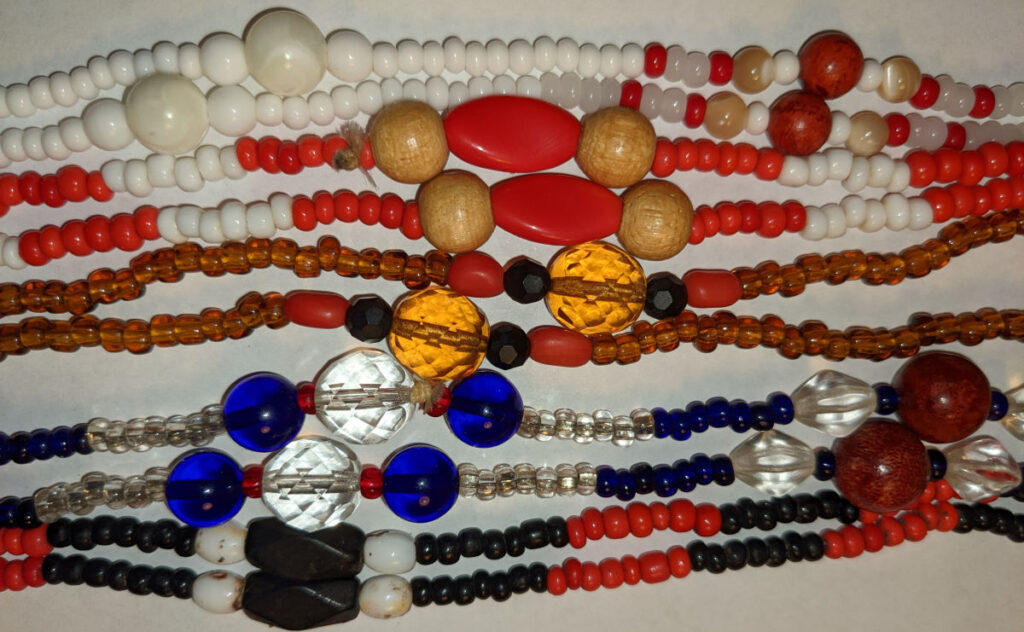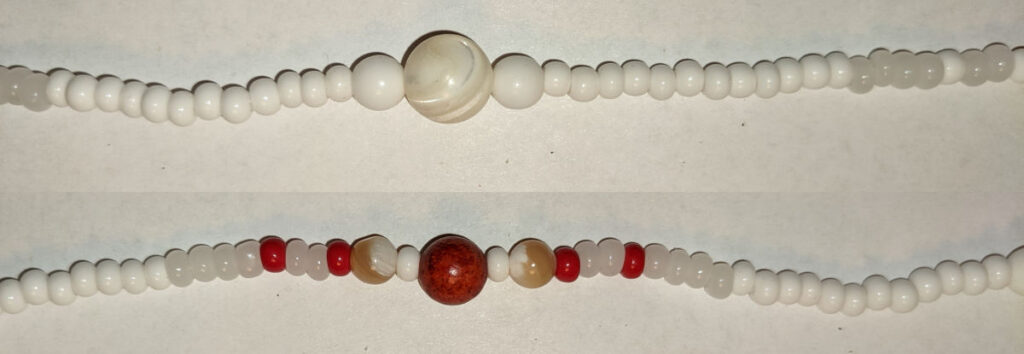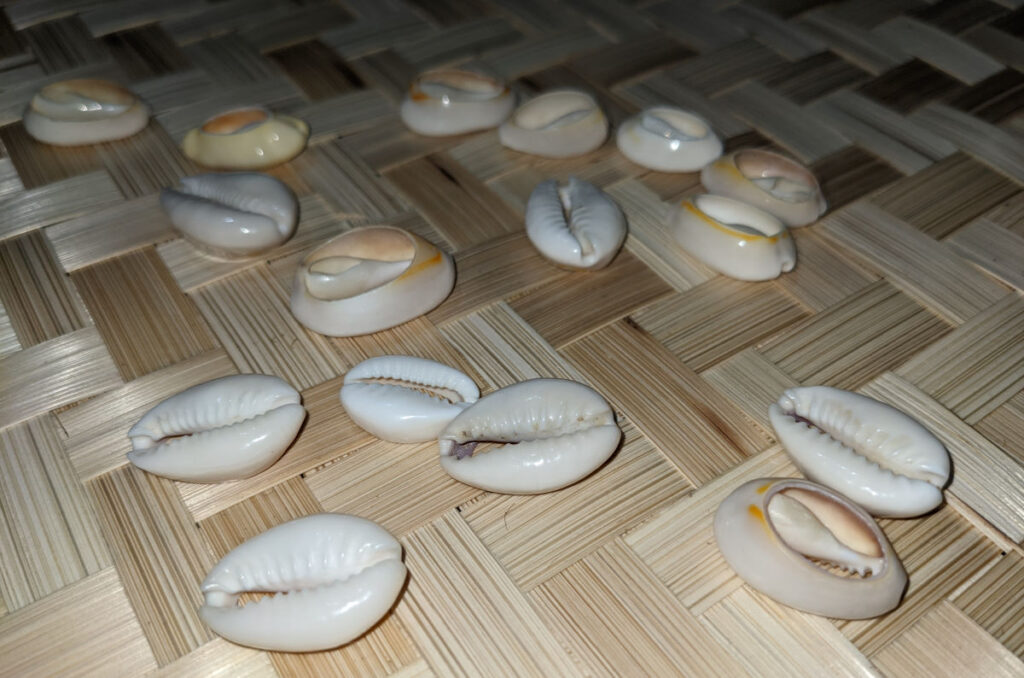An article about Santeria beads
by Everything Santeria

This article offers insights into the meaning of beads and colors in Santeria and Orisha worship.
I received my beads in 2001 after consultation with Elegba through divination.
The first reading with my future godfather did not close until Elegba said I needed Orisha in my life.
I received four elekes in a ritual that is often described as the baptism of Santeria.
The bead patterns on the four different necklaces represent the four pillar Orisha: Oshun, Yemaya, Shango, and Obatala.
The priests who prepared the necklaces came from a lineage of priests descending from slaves in Cuba.
I wear that history around my neck to this day and detail its significance here.
What are Eleke?
Eleke is the word used for beads by the Yoruba people of modern day Nigeria.
In Yoruba culture, beads represent identity, social status, and destiny of wealth.
Throughout history, Yoruba kings showed their rank by wearing elaborately beaded crowns.
The Yoruba arranged beads in number and color patterns to symbolize deities known as Orisha.
The Orisha embody venerated forces of nature and are facets of God known as Olodumare.
Many priests of the Orisha came to Cuba and other regions of the Americas in the 1800s as slaves.
Priests who survived the middle passage brought with them knowledge of Orisha worship.
Commonly called Santeria, Orisha worship spread beyond Cuba to the United States.
Today, Santeria practitioners wear necklaces with bead patterns of the Orisha inspired by their ancestors.
What is the meaning of Santeria beads color?
Each Orisha has a specific bead pattern that symbolizes characteristics of the Orisha.
The number and color of beads determines the pattern.
For example, the father of all the Orishas is Obatala.
The eleke of Obatala is made of white beads strung in groups of 8 or 16.
Bone, ivory, or mother-of-pearl often accent the white beads.
Variations in Obatala’s eleke represent different periods or roads of the Orisha’s existence.
For example, some roads of Obatala have white beads accented with red coral beads.
These variations in the eleke have corresponding myths and lessons.
A priest may prepare a particular eleke for a person experiencing a life lesson like in the myth.
What is the meaning of white Santeria beads?

But why are Obatala’s beads white?
Keep in mind that Obatala takes all things white.
He eats white goats, given offerings of white yam, and adorned with white beads.
Obatala’s characteristics are peace, purity, tranquility, and long life.
The white beads of Obatala’s eleke remind us of these qualities.
What is the meaning of red and black beads in Santeria necklaces?

You may have seen a person wearing elekes and noticed a repeating pattern of red and black beads.
Red and black are the colors of Elegba.
Elegba is the trickster Orisha who opens doors and makes everything possible.
We associate Elegba with the number 7.
The beads on an eleke for Elegba may include sections with 7 red followed by 7 black beads.
Other sections may alternate red and black beads, one after the other.
What is the meaning of black and white Santeria beads?

Some Elegba elekes include an alternating pattern of black and white beads.
The different bead patterns represent different ‘roads’ of Elegba.
For example, elekes for older roads of Elegba have more white beads and less red.
Elekes for younger roads of Elegba have more red beads and less white.
For Elegba, white beads represent old age more so than the peace and purity associated with Obatala.
What is the meaning of red and white beads in Santeria necklaces?

Red and white beads are another common bead pattern in Santeria.
Red beads symbolize a hot energy that is characteristic of Orishas, such as Elegba.
When strung together, red and white beads mean the Orisha Shango.
For Shango, red and white beads symbolize a balance between calmness and a fiery temperament.
Shango is an Orisha associated with fire, lightning, virility, and the potency of life.
But why does Shango take red AND white beads?
There is a myth that says Shango only wore necklaces of red beads.
But one day, Shango became enraged with another Orisha named Ogun, the Orisha of war.
Ogun offended Shango’s mother, then Shango lost his temper and filled the sky with lightning.
Obatalá, the father of the Orisha, heard of the fight and asked Shango to explain.
After hearing the story, Obatala gave Shango a basket of white beads.
Obatalá told Shango that his white beads symbolize the peace and wisdom of old age.
The story speaks of balanced responses to emotional events.
Shango’s red beads represent fiery impulses, the white beads represent the cooling restraint.
What is the meaning of blue and white or blue and clear Santeria beads?

Yemoja is the Orisha of motherhood and queen of all waters.
Blue beads combined with clear or milky white beads in groups of 7 symbolize her.
Yemoja’s blue beads represent the oceans.
Her white beads symbolize breast milk.
And clear beads remind us of amniotic fluid in the womb.
The eleke for Yemoja is accented with green, black, or red, depending on the road.
The shade of red in Yemoja’s eleke reveals the personality of the road.
Dark red beads that look like blood accent the eleke for Yemoja Ogunte, the warrior.
Pink coral beads accent the eleke for Yemoja Ashaba, a regal road of Yemoja.
Yemoja Ashaba was the first diviner with the diloggun and the wife of Orunmila.
Green and yellow beads mean Orunmila
Orunmila is the Orisha of divination.
Priests of Orunmila are known as Babalawos and wear necklaces of green and yellow beads.
The green beads represent the life of a green leaf.
The yellow beads represent the death of a wilting yellow leaf.
The combination of yellow and green symbolizes the balance in nature and life.
Santeria practitioners sometimes go to priests of Orunmila to receive green and yellow bracelets.
The bracelets show the devotee has received advice from Orunmila.
There are elekes for Oshun that are mostly yellow beads with green accents.
This may show the necklace is for Oshun.
Oshun is the Orisha of femininity, associated with honey, and takes beads made of amber.
Bead patterns for Oshun include translucent amber beads accented with black, green, and red.
Yellow and green beads are not exclusive to Orunmila.
Not everyone needs to wear a necklace of Santeria beads for protection.

Can anyone wear Santeria beads?
What are the rules with elekes?
You can find Santeria necklaces for sale on eBay and Etsy.
There are instructions you can find online about how to bless Santeria beads and make elekes.
But I do not recommend you do either of these.
An eleke in Santeria must be ritually prepared by a priest of Santeria.
Otherwise, even a necklace with the correct pattern is decorative and lacks the energy of the Orisha.
The Orisha are the ones that decide who wears elekes.
Priests in Santeria must prepare elekes according to the rules.
Elekes for the Orisha are to be worn by people marked to do so in divination.
Divination is a way for the Orisha to communicate with us how best to achieve our destiny.
In Santeria, a priest uses cowrie shells to consult with the Orishas on a person’s behalf.
The Orishas may say that a person needs to receive a consecrated eleke with the other implements sacred to that Orisha.
Other times, initiation isn’t necessary and the person need only wear an Orisha’s eleke for protection.
The general idea in Santeria is for people to only take part in ceremonies necessary for their destiny.
Though you might be interested in the Orisha, your destiny may not include elekes.
But you may have chosen a destiny filled with beads before birth.
It all comes down to when an Orisha chooses you.
Check out this link from the HistoryMiami Museum for great pictures of elekes from expert bead worker Mannolie DiSantos.